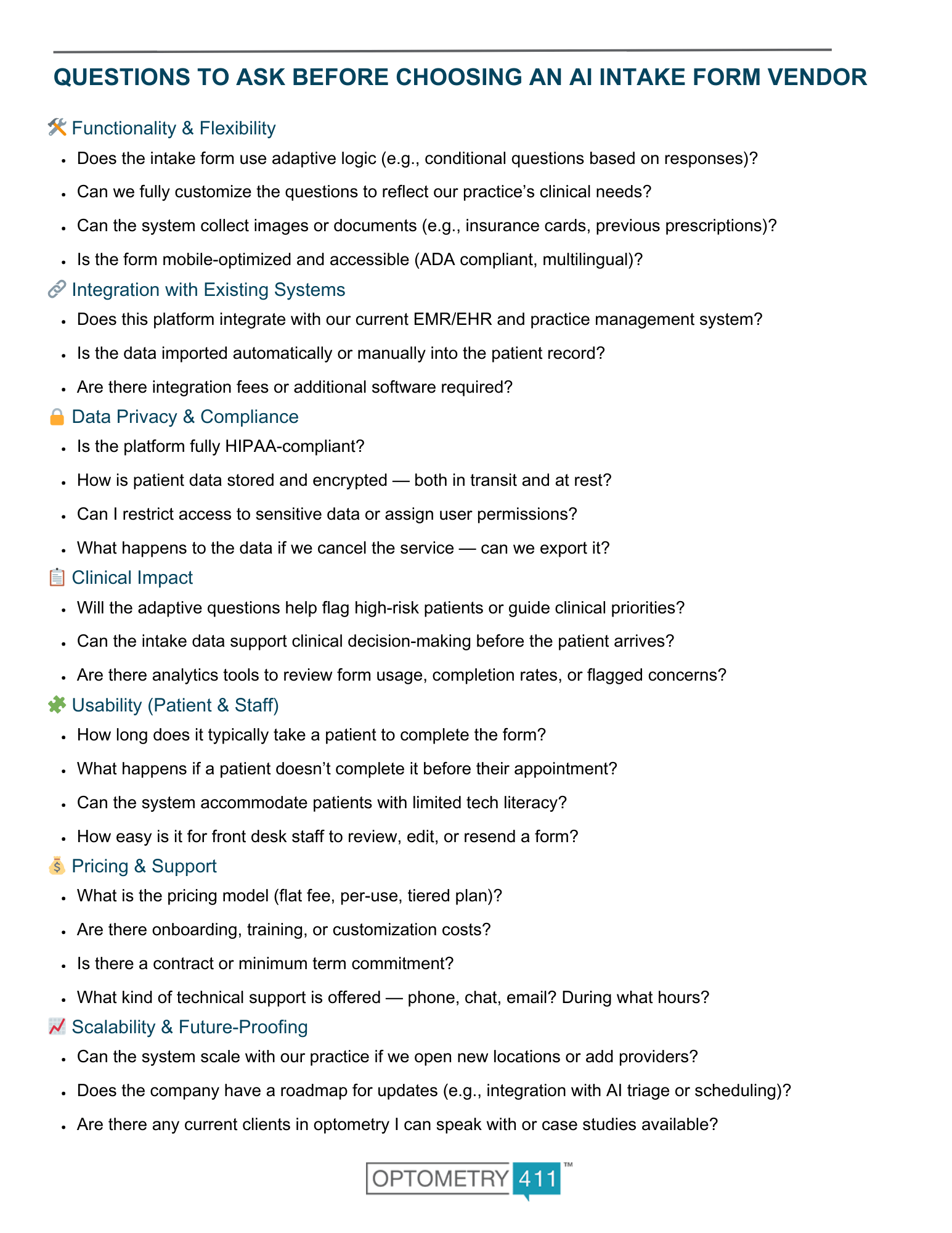AI-powered pre-screening is building steam in optometry. Adoption is not widespread yet, but innovations are most definitely being explored in larger and more tech-forward practices and for telehealth purposes.
Today, Optometry 411 shares what you need to know about adding AI intake forms to your optometry practice, plus a glimpse at what AI-powered triage will look like from a practical standpoint.
What is AI triage and how will it work?
- It starts with a pre-visit questionnaire. Patients will complete digital intake forms that use adaptive AI, which is smarter than a static form and adjusts follow-up questions based on the symptoms patients report. This type of intelligent form will also flag inconsistencies (like selecting both “no vision problems” and “blurred vision”) and prompt a patient to clarify.
- Patients are then flagged into categories like low-risk, moderate-risk, or urgent.
- Some current AI triage pilots take it a step further, incorporating instant analysis of OCTs, fundus photos, or corneal topography to spot signs of disease before an OD even reviews the scans.
- Ultimately, you can expect AI to integrate new information with a patient’s existing diagnostic data (previous IOP readings or OCT scans, etc.).
All in all, it’s shaping up to be a valuable first step to help you manage scheduling and referrals for better patient care. And getting better clinical data up front should give you more space during the exam to focus on diagnostics and personalized attention.
Speaking of diagnostics and personal attention: Here’s a very good point from Dr. Angela Shahbazian, OD, about AI in practice: “AI can increase access so everybody can get a diagnosis, but the care still requires human interaction and empathy and understanding … what people find valuable is when they feel like they’re actually being taken care of. A diagnosis is where care begins. If you get a diagnosis and that’s the end of it, you’re not being taken care of, you’re just being told something.”
I recommend the full article, AI in Practice, published by Berkeley’s Herbert Wertheim School of Optometry & Vision Science. It’s one of the better summaries of AI integration in optometry, with great perspective.
Real-world options to explore
If you’re interested in adding AI-powered intake forms to you practice, we’ve rounded up some companies (in alphabetical order) that offer this kind of technology. It’s a good place to begin your research.
Barti Software
Barti’s platform allows a practice to create adaptive intake forms that evolve based on patient responses. Besides gathering basic information, the system can integrate with AI transcription tools and reduce the need for manual data entry.
Formisoft
Similarly, Formisoft develops tools for clinics to create AI-powered forms that can automatically adjust to a patient’s needs. This includes pulling in relevant follow-up questions based on health history or appointment type.
Jotform
Jotform has introduced AI Agents that leave traditional forms into conversational experiences. These agents can guide users through the form-filling process, making it more interactive. The forms themselves can be customized based on user prompts.
mConsent
Digital intake forms that can be used by optometry practices to streamline paperwork. Their forms include features like conditional logic — where questions change based on patient answers — making the process faster and more personal.
Phreesia
Here’s another platform that supports logic-driven interviews that adapt to each individual patient and are designed to integrate seamlessly with existing EHR systems.
Puppeteer
They also offer an AI assistant designed to guide patients through intake forms using a conversational format. The system adjusts questions based on previous answers, helping clinics collect more relevant information before appointments.
And when you’re ready to take the next step, here’s a list of important questions you’ll want to ask vendors before deciding on/implementing anything new. Note: Click the image for a printable PDF version.






